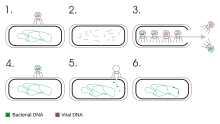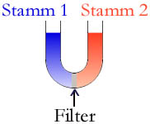Transduction (genetics)
As transduction in is genetics of gene transfer by viruses called. Usually viral, but occasionally bacterial or artificial genes are transferred. The infection of target cells with viral vectors is also referred to as transduction, in which case foreign genes are also transferred with the help of viruses.
In addition to transformation and conjugation, transduction is one of three options for gene transfer.
Transduction in genetic engineering
Transduction is used in genetic engineering and gene therapy to bring genetic material into eukaryotes through viral vectors such as adeno-associated viruses . It is an often used tool in basic research and a potential candidate as the core mechanism of gene therapy.
Nonspecific (general) transduction
The transfer of bacterial DNA by a virulent bacteriophage is called unspecific or general transduction . During phage reproduction in the bacterial cell ( lytic cycle ) it can happen by chance that instead of the phage DNA, a piece of the bacterial DNA is incorporated into a phage, which was previously broken down into fragments under the control of the phage DNA. If this phage infects another cell, the bacterial DNA is incorporated ( recombined ) into its bacterial genome .
Specific (special) transduction
Temperate phages are viruses whose DNA, after injection into the host cell, does not enter the lytic cycle , but occasionally the lysogenic cycle and enter a resting phase (example: bacteriophage lambda ). In most cases, the phage DNA is first integrated into the main chromosome of the host at a certain point (in Escherichia coli this is the att region). An exception with an episomal genome is e.g. B. the phage P1. This integrated or circular phage DNA is referred to as prophage. This does not affect the vitality of the host cell. It multiplies and so does the prophage. The integration of a phage can even turn out to be advantageous for the bacterium, since wearing the prophage often protects against superinfection of other bacteriophages of the same species. If the environmental conditions deteriorate and the host cell threatens to die off, for example due to UV rays or chemicals, the phage enters the lytic cycle because a dead host is no longer available for a virus to reproduce. If the prophage is inaccurately cut out ( excision ) from the host's genome, the phage DNA can randomly take a piece of bacterial DNA with it and incorporate it into another bacterium. In genetic engineering, this property is used to transfer certain areas of DNA from one bacterium to another. It is true that during the excision the bacteriophage does not specifically take away DNA segments from the host cell, but only with a statistical probability. Is there a selection marker on the DNA segment that you want to transfer from one bacterium to another by means of transduction, such as e.g. B. an antibiotic resistance gene, survive the selection only those bacteria that received the desired DNA segment and incorporated by homologous recombination.
Trials by Lederberg, Tatum and Zinder
After Edward Lawrie Tatum and Joshua Lederberg had already shown conjugation to Escherichia coli in 1947 , Lederberg and Norton Zinder coined the term "transduction" in 1952 for a previously unknown process that they were able to demonstrate in an experiment with the causative agent of mouse typhoid , Salmonella typhimurium : The two legs of a U-tube, which were separated by a filter that was only permeable to particles that are smaller than the bacterial cells, were loaded with two strains of S. typhimurium .
Strain 1 was a deficiency mutant only for the amino acid histidine , and strain 2 only for the amino acid tryptophan .
| tribe | Histidine synthesis | Tryptophan Synthesis |
|---|---|---|
| 1 | not possible | possible |
| 2 | possible | not possible |
After a few hours of incubation , bacteria could be detected in addition to the representatives of the two strains 1 and 2, which could produce both histidine and tryptophan themselves. In addition, free bacteriophages (P22) which were not present at the start of the experiment could be observed in the suspension .
Since the bacteria could not come into direct contact with one another, conjugation was impossible. A transformation could also be excluded because no free DNA could be found in the two legs of the U-tube. The conclusion was that the bacteriophages had transferred parts of the genome from bacteria of one strain to cells of the other strain.
literature
- Tara Rodden Robinson, Jan Schneider: Genetics for Dummies . Wiley-VCH , Weinheim 2006, ISBN 3-527-70272-5 .
- Duden Abitur knowledge . Biology. Bibliographisches Institut, Mannheim 2007, ISBN 978-3-411-00251-1 , p. 142,180,240 .
- Susanne Modrow, Dietrich Falke , Uwe Truyen: Molecular Virology. An introduction for biologists and medical professionals. 2nd Edition. Spectrum textbook, Heidelberg 2002, ISBN 3-8274-1086-X . (with references, English translation 2006) .
- David M. Knipe, Peter M. Howley, et al. (Ed.): Fields' Virology . (2 volumes; standard work on virology) 5th edition, Lippincott Williams & Wilkins, Philadelphia 2007, ISBN 978-0-7817-6060-7 .
Web links
Individual evidence
- ^ BR Schultz, JS Chamberlain: Recombinant adeno-associated virus transduction and integration. In: Molecular therapy: the journal of the American Society of Gene Therapy. Volume 16, number 7, July 2008, pp. 1189–1199, doi: 10.1038 / mt.2008.103 , PMID 18500252 , PMC 2574934 (free full text) (review).
- ^ Alberts , Bray, Johnson, Lewis: Textbook of Molecular Cell Biology, 2nd, corrected edition Wiley-VCH, Weinheim 2001, ISBN 3-527-30493-2 .
- ^ ND Zinder, J. Lederberg: Genetic exchange in Salmonella. In: Journal of bacteriology. Volume 64, number 5, November 1952, ISSN 0021-9193 , pp. 679-699, PMID 12999698 , PMC 169409 (free full text): "study of gene recombination in Escherichia coli (Tatum and Lederberg, 1947; Lederberg et al., 1951) suggested that a similar approach should be applied to other bacteria. ... a new descriptive term, transduction ".


